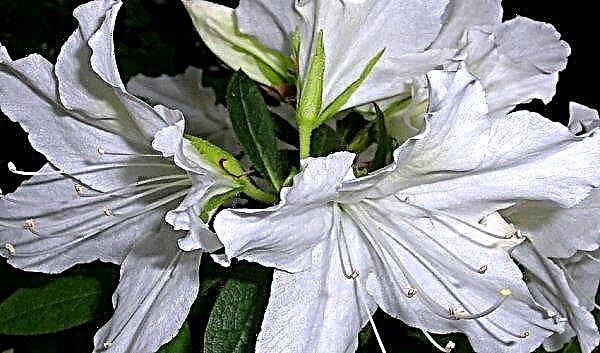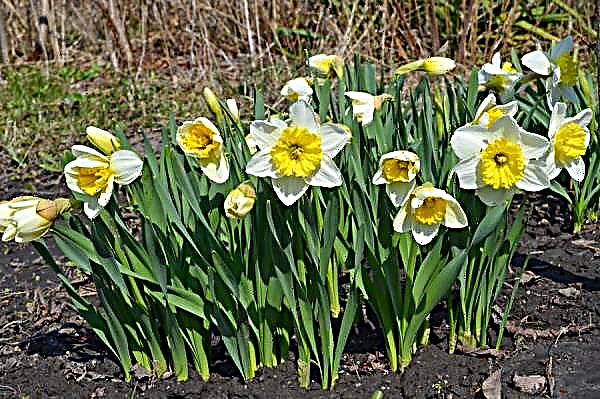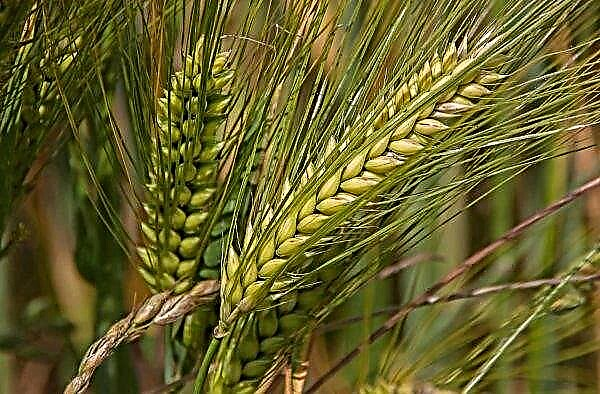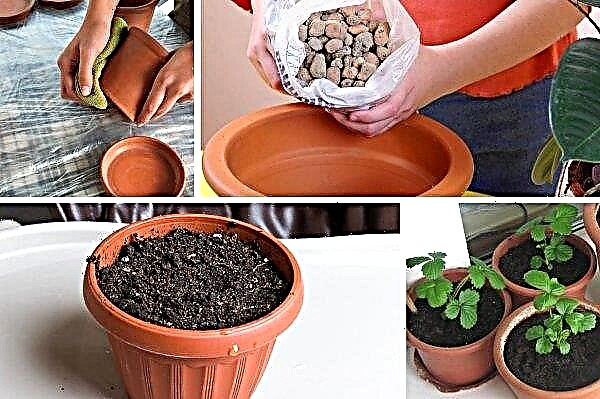Siberian iris is a successful combination of exquisite decorativeness and unpretentiousness. In addition, bright perennial flowers will decorate any garden or flower bed throughout the season. What varieties are best grown and how to achieve more magnificent flowering in the care of this crop, find out further from the article.
Description and variety varieties
Elegance, brightness, versatility in landscape design, endurance to pests and colds, reliability for decades - these are the most accurate characteristics of a laconic description of Siberian irises.
In the natural environment, they grow in Eastern and Central Europe, as well as in North Asia. Natural specimens of this herbaceous perennial plant differ in height over 1 m, as well as violet-blue and pale milk color of the petals.
Hybrid species are from 60 to 100 cm high and strike a wide palette of colors: from pale purple to bright yellow, crimson and burgundy. In addition, breeders enriched the assortment of popular culture with terry, two-color, large-flowered, fringed varieties, which in total are accrued more than a hundred.
Each of them can have a different stem height, shape and number of flowers, as well as the color of the petals and the timing of flowering.Did you know? Translated from the ancient Greek language, “iris” means a rainbow. It is believed that Hippocrates, who gave this name to flowers, back in the 4th century BC. e., thus perpetuated the name of the mythical goddess Irida, who, carrying the will of the Olympic gods to people, each time descended to the earth along a rainbow arc.
The main features of a perennial are:
- rigid linear foliage of green color, which is always shorter than the stems, its length varies between 50–80 cm, and the width is not more than 4 cm;
- lack of framing on the lower petals (beardlessness);
- lack of aroma;
- splendor of buds, which in some cases can reach a diameter of more than 10 cm;
- the presence of up to 8 flowers on one peduncle.
Video: Siberian Iris
Double Standard
The variety is a perennial up to 70 cm high with lush purple and lilac inflorescences that appear in mid-summer. Double Standard flowers reach a diameter of 15 cm and consist of 3 tiers of an unpaired number of petals of different sizes.
Did you know? The prototype of the famous emblem of royal power in Europe were irises.
Their peculiarity lies in the uneven contour of the edges, as well as in the bright yellow middle of the buds, covered with clear purple lines. Flowering hybrid lasts for several weeks.
Contrast In Styles
The hybrid is characterized by a bush height of up to 75 cm and early flowering. Its large multi-color buds, depending on the climatic characteristics of a particular region, are revealed from May to June.
The rich color of the burgundy on the petals compares favorably with the blue halo and the white center following it with light blue blotches. The middle of the flowers is traditionally yellow. Buds of this variety consist of 3 large and 3 medium petals. The latter are distinguished by a delicate burgundy shade.Did you know? In ancient times, wealthy nobles were content with a drink of fried iris seeds, which tastes like coffee. The raw materials were very expensive, so not everyone could purchase them.

Miss Apple
Among the whole variety of purple shades of Siberian irises, this variety is as close as possible to bright red. Its inflorescences open in June and are a collection of large and very bright buds.
The outer flower petals are characterized by a more saturated color and have a yellow halo with clear dark violet lines. The inside of the terry bud is plain and more delicate. The adult bush develops to a height of 75 cm.
IC Stars
The hybrid is unique due to the harmonious combination of cool white and blue colors. Its flowering begins in the summer, approximately from the second decade of June. The height of thick peduncles reaches 80 cm. The buds are medium sized, but consist of 3 tiers of petals of different sizes.
The lower and middle ones are distinguished by the presence of white eyes with dark stripes, and the upper ones by a delicate, lilac-blue hue, a distinct vein in the center and forked edges.
Kita No Sise
The bush of this variety extends to a height of 70 cm and differs from other varieties of irises with a bluish shade of foliage. Therefore, experts recommend it for planting in "cold" compositions and indicate the absence of a sharp contrast with other plants.
Another hybrid is appreciated in gardening, thanks to its large double flowers of a gentle light lilac color. Their diameter corresponds to 14–15 cm. The bud consists of 3 tiers of different sizes 15 petals. At the base, they all have a creamy yellow veined middle. Moreover, the transition between the core and the general color background is so sharp that it seems as if a flower appeared from nowhere. The hybrid begins to bloom in late June.Important! When buying planting material for Siberian irises, choose specimens with a strong and holistic root system, well-developed buds and saturated green foliage.

Healing properties
In addition to high decorativeness, irises have healing properties. This feature of them is due to the unique chemical composition of plant fibers.
Among the valuable nutrients of the flower, vitamins (A, beta-carotene, E, C, K, B1, B2, B4, B5), micro and macro elements (calcium, iron, phosphorus, potassium, sodium, zinc, copper, selenium) were found, as well as essential oils. Due to the high concentration of nutrients, the bulbs are used in medicine and cosmetology.
- Their therapeutic effect is manifested in:
- protecting the body from premature aging;
- stimulation of the immune system;
- cell regeneration;
- antioxidant and antibacterial effects;
- pain relief
- relieve nervous tension;
- astringent and homeopathic properties;
- the ability to remove sputum from the body during inflammatory processes in the respiratory system;
- cleansing the blood and improving its formula.

Traditional healers advise using iris raw materials for the manufacture of eye drops, expectorant and antimicrobial decoctions, as well as to relieve toothache, treat the pancreas, urogenital system; healing of festering wounds and internal ulcers. It is noted that a decoction of Siberian iris can withstand even tubercle bacillus. However, with individual intolerance and illiterate intake, it can only harm the body.
Important! The yellowed foliage of iris seedlings indicates its preliminary drying for several days. Such planting material is not suitable for long-distance transportation.
Growing Features
Siberian irises, including breeding ones, can grow without special care both in the southern and northern regions. They are characterized by high winter hardiness and unpretentiousness to environmental conditions. But if you take into account the elementary agrotechnical rules for growing flowering crops, you can strengthen the process of budding and extend it for several days.
Video: Conditions for growing Siberian irises
Landing rules
Irises develop better in open areas with loose, slightly loamy soil. Therefore, it is desirable to plant them in well-lit elevated places where cold air is not collected and there are no through winds. Beware worth the acidic and poor nutrient soils.
In such conditions, the plant will not be able to form a full-fledged bush, it will languish and die. To achieve maximum flowering splendor is possible only on well-drained alkaline zones.
Important! The best period for planting irises is the end of August - the beginning of September.
Therefore, do not neglect the following rules for adjusting soils:
- Marshy areas require special drainage from expanded clay or brick chips.
- Frequent watering will be necessary to increase the humidity level in places with an excessively dry substrate.
- On poor sandy soils, before planting irises, it is imperative to introduce clay and nitrogen-containing fertilizers.
- The oxidized medium can be alkalized with a well-known cannon, dolomite flour, cement dust or old plaster, contributing 150–300 g / m².
- Excessive alkali is corrected using peat.

In order to plant a hybrid, you must:
- Pre-prepare the site, cleaning it of debris and weeds, as well as digging the earth to the depth of a bayonet-shovel.
- Shorten the roots and foliage of seedlings by a third.
- If necessary, clean and disinfect affected root processes. This procedure is relevant when transplanting diseased specimens. It is better to carry out a weak solution of potassium permanganate.
- Make holes of the appropriate depth (3-5 cm), observing the distance between adjacent bushes within 1 m. The plants grow rapidly and do not tolerate frequent replanting, therefore, in cramped conditions, they can completely stop blooming.
- Water the grooves made, place the roots of the plant in them and sprinkle them with earth. After that, seal the hole.
- Mulch the area with peat, compost or mowed grass. Mulch will prevent weed growth and retain moisture in the soil.

The subtleties of care
Selection varieties of Siberian iris, as well as wild species, can grow without human intervention. But for productive cultivation, the grower needs to periodically take the following measures:
- Depending on weather conditions, water the crop, since it belongs to a moisture-loving floral group. In a drought, this procedure is appropriate at least once a week. And in the rainy season you need to wait until the soil dries to a depth of 2-3 cm.
- Every six months, update the mulch on the site.
- During the season, fertilize irises three times. For the first time, this must be done with mineral complex substances when the bush is covered with dense foliage. The second top dressing from organic substances (rotted hay or compost) is appropriate at the beginning of flowering, and the third, potassium phosphorus, is when the flowers begin to fall off. It is important to consider that the bushes can be sprayed only in the morning or evening, protecting the inflorescences from the ingress of the solution.
- Regularly remove faded peduncles. This is done in order to accumulate the strength of the bush for new buds.
- Every year in the fall, when the weather is stable and cold, cut the foliage on the bushes, leaving up to 15 cm from the surface of the earth. Pruning carried out too early is fraught with intensive build-up of green biomass, which is fraught with freezing in winter.
- Transplant irises every 5-10 years. This feature of culture is associated with a long period of its survival in a new place. Therefore, the annual transplant is not relevant.
 Siberian irises can withstand frosts up to 35 ° C. Therefore, they do not require additional shelter and preparation for the winter. An overly thick layer of mulch on the flowerbed can lead to overheating of the roots.
Siberian irises can withstand frosts up to 35 ° C. Therefore, they do not require additional shelter and preparation for the winter. An overly thick layer of mulch on the flowerbed can lead to overheating of the roots.
Pests and diseases
Under favorable growing conditions, this type of iris demonstrates high resistance to parasites, fungal and bacterial infections. And in case of violation of elementary agrotechnical rules, gardeners can encounter such diseases of the bushes:
- bacterial rot (occurs due to an excessive amount of nitrogen in the soil, its pathogens are activated in the spring, manifested by brown soft spots on the foliage);
- Fusarium (the reasons for its development are improper care and excessive dampness in the soil, manifested by rotting of the root bulb);
- spotting (caused by violations of the moisture regime and acid soil, manifested by the formation of dark spots of various shapes on the leaves);
- gray root rot (pathogens are activated in the summer during prolonged rains, manifested by specific mold on the aerial part of the bushes, as well as pale foliage).

To avoid ailments in the flower garden, you must regularly inspect all of its plants. Suspicions should cause any neoplasms on the stems, leaves or buds. Also, the disease is indicated by the lag of the bushes in development and any deformation on them.
In case of infection, you will need:
- Remove affected parts.
- To disinfect soil with a weak solution of potassium permanganate.
- Spray the culture with any fungicide (Fitosporin, Skor, Fitoverm).
- In the future, adjust the level of soil moisture in the area and frequency of feeding.

Excessive dampness and acidic environment attract not only pathogens of fungal infections, but also harmful insects. Caterpillars, slugs and aphids can threaten irises. Insecticidal solutions ("Aktara", "Confidor", "Actellik") are the salvation from pests.
Did you know? In Christianity, the iris is associated with the Virgin Mary, denoting her sadness and purity.
Iris in landscape design
In floriculture, the value of Siberian irises lies not only in luxurious flowering, but also in the decorativeness of the entire bush. If the faded buds fall after a few weeks, then bright green foliage decorates the flower bed from spring to the coldest.
Such a culture is perfect for group compositions, mixborders, rock gardens, decorations of the coastal zones of reservoirs. Focusing on the colors of a particular variety and flowering time, you can successfully combine neighboring plants and achieve eternal flowering in the garden.
Siberian irises deserve attention due to their resistance to colds, diseases and pests. They are not demanding in care and can pleasantly surprise with the beauty of their flowering.












